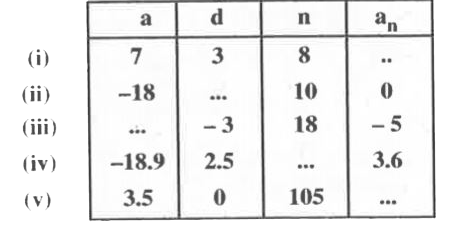रिक्त स्थानों को भरिए :
(a)(−8)+________=0 (b)13+______=0
(c)12+(−12)=_____ (d)(−4)+____=−12
(e)_____−15=−10
The correct Answer is:(a)8(b)−13(c)0(d)−8(e)5
Step by step video, text & image solution for रिक्त स्थानों को भरिए : (a)(-8)+"________"=0" "(b)13+"______"=0 (c )12+(-12)="_____ "(d)(-4)+"____"=-12 ( e) "_____"-15=-10 by Maths experts to help you in doubts & scoring excellent marks in Class 6 exams.
Topper's Solved these Questions
Similar Questions
संख्या रेखा का प्रयोग करते हुए , वह पूर्णांक ज्ञात कीजिए जो
(a) 5 से 3 अधिक हैं ( b ) -5 से 5 अधिक हैं
(c ) 2 से 6 कम हैं (D ) -2 से 3 कम हैं03:39View Solutionनिम्निलिखित में से किस्से शुन्य निरूपित नहीं होगा?
(a) 1+0, (b) 0×0 , ( c) 02, (d) 10−10206:42View Solution75∘ माप वाले कोण ∠POQ की रचना कीजिए और इसकी सममित अक्ष खींचिए ।
01:40View SolutionFill in the blanks. (a) (−8)+[−?][−?][−?][−?]=0(b)13+[−?][−?][−?][−?][−?]=0(c)12+(−12)(d)(−4)+=−1(e)−15=−10
01:38View Solutionif D=det[[10!,11!,12!11!,12!,13!12!,13!,14!]] then (D)/((10!)^(3))-4 is:
00:51View SolutionIn Figure, if yx=5 and zx=4, then the value of x is (a) 80 (b) 180 (c) 120 (d) 150
 02:04View Solution
02:04View SolutionA fraction equivalent to 812 is 8+412+4 (b) 8÷412÷4 (c) 8−412−4 (d) None of these
02:22View Solution9, 12, 11, 14, 13, (.....), 15
(a) 12
(b) 16
(c) 10
(d) 1702:07View SolutionThe value of |[a,a+d,a+2d] , [a+d,a+2d,a+3d] , [a+2d,a+3d,a+4d]|+|[b
04:16View SolutionThe median of the data 13, 12, 10, 8, 4, 6, and 15 is 10.
01:57View Solution1) Fragmentation () a) Planaria br 2) Unripe fruits () b) Yeast br 3) Desire () c) Spirogyra br 4) Reproduction () d) Watermelon br
05:16View Solutionनिम्नलिखित सारणी में, रिक्त स्थानों को भरिए, जहाँ A.P. का प्रथम पद a , सार्व अंतर d और nवाँ पद a_nहै:
 01:35View Solution
01:35View SolutionNr−(CH2)12−C≡CHNaNH2−−−−→(A)Lindlar−−−−−−−→Catalyst(B), Product (B) is:
02:02View SolutionFill in the blanks. (a)(-8) +[ ]=0 (b) 13+[ ] =0 (c) 12+(-12)= [ ] (d) (-4)+[ ]=-12 (e) [ ] -15=-10
02:03View SolutionA fraction equivalent to 812 is
03:04View SolutionFind correct features w.r.t. most advanced type of placentation. Br a. Parietal in Argemone. Br b. Basal in cereals. Br c. Axile in solanaceae. Br d. Unilocular ovary. Br e. Ovary with single ovule
04:17View Solution

